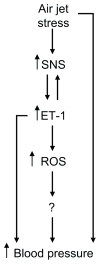Endothelin activation of reactive oxygen species mediates stress-induced pressor response in Dahl salt-sensitive prehypertensive rats
- PMID: 20547970
- PMCID: PMC2921634
- DOI: 10.1161/HYPERTENSIONAHA.110.152629
Endothelin activation of reactive oxygen species mediates stress-induced pressor response in Dahl salt-sensitive prehypertensive rats
Abstract
Experiments were designed to test the hypothesis that endothelin (ET) and/or reactive oxygen species contribute to the pressor response induced by acute air jet stress in normotensive Dahl salt-sensitive rats maintained on a normal salt diet (prehypertensive). Mean arterial pressure was chronically monitored by telemetry before and after 3-day treatment with the free radical scavenger 4-hydroxy-2,2,6,6-tetramethyl piperidinoxyl (Tempol) or ET receptor antagonists ABT-627 (ET A antagonist) or A-182086 (ET A/B antagonist) supplied in the drinking water. Rats were restrained and subjected to pulsatile air jet stress (3 minutes). Plasma samples at baseline and during acute stress were analyzed for 8-isoprostane (measure of reactive oxygen species production) and ET. Neither Tempol nor ET receptor antagonist treatment had an effect on baseline mean arterial pressure or plasma 8-isoprostane. The pressor response to acute stress was accompanied by significant increases in plasma 8-isoprostane and ET. Tempol significantly reduced both the total pressor response (area under the curve) and the stress-mediated increase in plasma 8-isoprostane; conversely, Tempol had no effect on the stress-induced increase in plasma ET. Combined ET(A/B) antagonism, but not selective ET(A) receptor blockade, similarly suppressed the pressor response to stress and stress-mediated rise in 8-isoprostane. Together these results indicate that reactive oxygen species contribute to the pressor response to acute air jet stress. Furthermore, the increase in reactive oxygen species occurs downstream of ET(B) receptor activation.
Figures






Comment in
-
How are stressed prehypertensive rats pressured? Endothelin pleads guilty.Hypertension. 2010 Aug;56(2):191-2. doi: 10.1161/HYPERTENSIONAHA.110.154013. Epub 2010 Jun 14. Hypertension. 2010. PMID: 20547969 No abstract available.
References
-
- Schnackenberg CG. Physiological and pathophysiological roles of oxygen radicals in the renal microvasculature. Am J Physiol Regul Integr Comp Physiol. 2002;282:R335–342. - PubMed
-
- Touyz RM. Reactive oxygen species, vascular oxidative stress, and redox signaling in hypertension: what is the clinical significance? Hypertension. 2004;44:248–252. - PubMed
-
- Taniyama Y, Griendling KK. Reactive oxygen species in the vasculature: molecular and cellular mechanisms. Hypertension. 2003;42:1075–1081. - PubMed
-
- Xu H, Fink GD, Chen A, Watts S, Galligan JJ. Nitric oxide-independent effects of tempol on sympathetic nerve activity and blood pressure in normotensive rats. Am J Physiol Heart Circ Physiol. 2001;281:H975–980. - PubMed
-
- Shokoji T, Fujisawa Y, Kimura S, Rahman M, Kiyamoto H, Matsubara K, Moriwaki K, Aki Y, Miyatake A, Kohno M, Abe Y, Nishiyama A. Effects of local administration of tempol and diethyldithio-carbamic on peripheral nerve activity. Hypertension. 2004;44:236–243. - PubMed
Publication types
MeSH terms
Substances
Grants and funding
LinkOut - more resources
Full Text Sources
Medical

